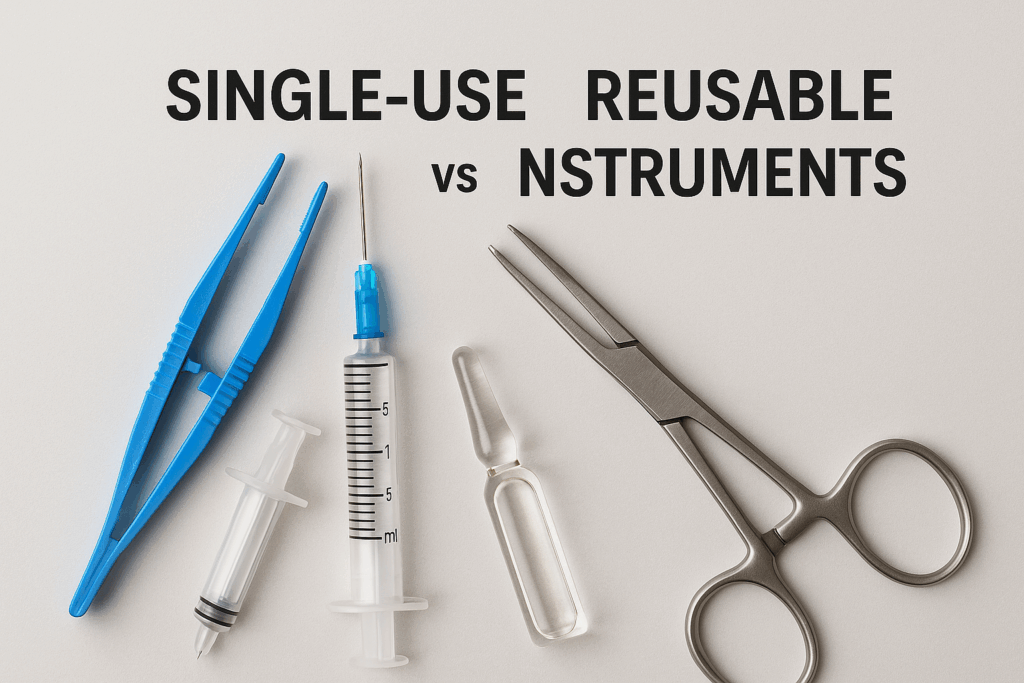When it comes to choosing dental instruments, one key decision can shape your clinic’s efficiency, safety, and budget: Should you use single-use or reusable instruments?
Both types have their pros and cons, and the best choice often depends on your practice size, treatment types, sterilization capabilities, and overall goals. Let’s break it down so you can make a confident, informed decision.
What Are Single-Use Instruments?
Single-use instruments (also called disposables) are designed to be used once and then discarded. They’re usually, pre-sterilized and individually packaged.
✅ Common examples:
– Syringes
– Saliva ejectors
– Exam mirrors (in some setups)
– Explorers
– Plastic composite instruments
What Are Reusable Instruments?
Reusable instruments are designed to withstand sterilization and multiple uses. They’re typically made from high-quality stainless steel or other durable materials.
✅ Common examples:
– Scalers and curettes
– Elevators and forceps
– High- and low-speed handpieces
– Periodontal probes
– Surgical instruments
Pros and Cons: Side-by-Side Comparison
✅ Benefits of Single-Use Instruments:
– Zero cross-contamination risk (no need for sterilization)
– Time-saving (no processing time between patients)
– Idea for mobile clinics or high-turnover environments
-Compliant with strict infection control standards
🚫 Drawbacks of Single-Use Instruments:
– Higher long-term cost
– More medical waste
– Often less durable or ergonomically designed
– Not suitable for complex procedures
✅ Benefits of Reusable Instruments:
– Cost-effective over time
– Environment friendly (less waste)
– Usually offer better tactile feel and precision
– Ideal for complex treatments and surgical procedures
🚫 Drawbacks of Reusable Instruments:
– Requires strict sterilization protocols
– Higher upfront cost for equipment and training
– Risk of improper sterilization if not managed well
– Time-consuming to clean, pack, and autoclave
Key Factors to Consider for Your Practice
- Practice Type & Volume
– Busy, fast-paced clinics may benefit from disposables for speed and simplicity
– Specialty or surgical practices may prefer reusables for quality and durability. - Sterilization Infrastructure
– Do you have autoclaves, trained staff, and proper tracking systems?
– If not, disposables might be safer until your setup improves. - Budget & Long-Term Costs
– Single use may be cheaper initially, but reusable instruments offer savings over time with proper maintenance. - Infection Control Standards
– For high-risk cases or immunocompromised patients, single-use tools can add an extra layer of protection - Sustainability Goals
-If your clinic values eco-conscious practices, reusable instruments significantly reduce waste
A Hybrid Approach: Best of Both Worlds
Many modern dental practices adopt a hybrid approach: using reusable instruments for standard procedures and disposables for high-risk or hard-to-clean items. This strikes a balance between safety, sustainability, and cost-effectiveness.
Final Thoughts: There’s No One-Size-Fits-All Answer
Choosing between single-use and reusable instruments depends on your clinical needs, resources, and priorities. What matters most is ensuring your tools support high-quality care, meet infection control standards, and align with your practice’s vision.
When in doubt, consult your infection control advisor and run a cost-benefit analysis tailored to your clinic size and patient volume.

